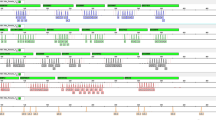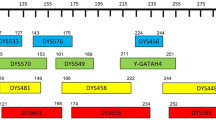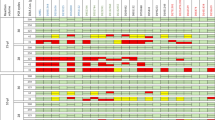Abstract
Many highly polymorphic minisatellite loci can be detected simultaneously in the human genome by hybridization to probes consisting of tandem repeats of the ‘core’ sequence1. The resulting DNA fingerprints produced by Southern blot hybridization are comprised of multiple hypervariable DNA fragments, show somatic and germline stability and are completely specific to an individual2,3. We now show that this technique can be used for forensic purposes; DNA of high relative molecular mass (Mr) can be isolated from 4-yr-old bloodstains and semen stains made on cotton cloth and digested to produce DNA fingerprints suitable for individual identification. Further, sperm nuclei can be separated from vaginal cellular debris, obtained from semen-contaminated vaginal swabs, enabling positive identification of the male donor/suspect. It is envisaged that DNA fingerprinting will revolutionize forensic biology particularly with regard to the identification of rape suspects.
This is a preview of subscription content, access via your institution
Access options
Subscribe to this journal
Receive 51 print issues and online access
$199.00 per year
only $3.90 per issue
Buy this article
- Purchase on Springer Link
- Instant access to full article PDF
Prices may be subject to local taxes which are calculated during checkout
Similar content being viewed by others
References
Jeffreys, A. J., Wilson, V. & Thein, S. L. Nature 314, 67–73 (1985).
Jeffreys, A. J., Wilson, V. & Thein, S. L. Nature 316, 76–79 (1985).
Jeffreys, A. J., Brookfield, J. F. Y. & Semeonoff, R. Nature 317, 818–819 (1985).
Burgess, R. M., Sutton, J. G. & Whitehead, P. H. J. forens. Sci. 24, 392–396 (1979).
Gerler, A. & Nagai, T. Z. Rechtsmed 90, 15–18 (1983).
Divall, G. B. Electrophoresis 6, 249–258 (1985).
Sensabaugh, G. F. Isoenzymes: Current Topics in Biological and Medical Research Vol. 6, 247–282 (Liss, New York, 1982).
Denault, G. C., Takimoto, H. H., Kwan, Q. Y. & Pallos, A. J. forens. Sci. 25, 479–498 (1980).
Blake, E. T. & Sensabaugh, G. F. J. forens. Sci. 21, 784–796 (1976).
Davies, A., Lincoln, P. J. & Martin, P. Forens. Sci. Int. 25, 201–208 (1984).
Kishi, K. & Iseki, S. J. Immunogenet. 2, 205–210 (1975).
Higuchi, R., Bowman, B., Freiberger, M., Ryder, O. A. & Wilson, A. C. Nature 312, 282–284 (1984).
Pääbo, S. Nature 314, 644–645 (1985).
Calvin, H. I. & Bedford, J. M. Reprod. Fert., Suppl. 13, 65–67 (1971).
Maniatis, T., Fritsch, E. F. & Sambrook, J. Molecular Cloning: A Laboratory Manual (Cold Spring Harbor Laboratory, New York, 1982).
Author information
Authors and Affiliations
Rights and permissions
About this article
Cite this article
Gill, P., Jeffreys, A. & Werrett, D. Forensic application of DNA ‘fingerprints’. Nature 318, 577–579 (1985). https://doi.org/10.1038/318577a0
Received:
Accepted:
Published:
Issue Date:
DOI: https://doi.org/10.1038/318577a0
This article is cited by
-
Using cluster analysis for grouping partial autosomal haplotypes derived from single sperm STR profiling
Rechtsmedizin (2024)
-
Single-cell transcriptome sequencing allows genetic separation, characterization and identification of individuals in multi-person biological mixtures
Communications Biology (2023)
-
Solving the two-decades-old murder case through joint application of ZooMS and ancient DNA approaches
International Journal of Legal Medicine (2023)
-
Use of hormone-specific antibody probes for differential labeling of contributor cell populations in trace DNA mixtures
International Journal of Legal Medicine (2022)
Comments
By submitting a comment you agree to abide by our Terms and Community Guidelines. If you find something abusive or that does not comply with our terms or guidelines please flag it as inappropriate.



